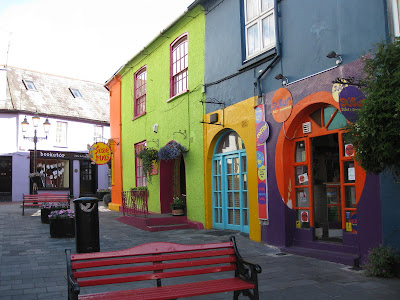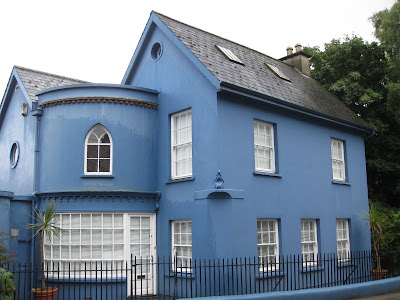We really enjoyed the rewards of getting up early today. We left Garrettstown House Holiday Park, €23 plus €1 each for showers, at 8 am in order to have the time to get lost, find parking and meet up with a walking tour by 9:15. Everything was very quiet and we were the only vehicle on the road. Rick Steves, bless the man, recommended a large, free, safe parking lot across from St. Multose Church. Parking is always one of our biggest challenges in small, medieval towns. The sun was shining and we even had time for tea and scones at Mother Hubbards.
Campsite yesterday afternoon

Mother Hubbards

Tea and scones

I love all the colorful buildings in this very nice town. It has lots of charm and felt like a real working town even with tourists around.

The walking tour starts outside the tourist office right down by the harbor where we met up with Don from Don & Barry’s Kinsale Historic Stroll. Only one other couple showed up; so Don suggested we do something different—he offered to drive us to several spots so we could see and understand more of the history of the town. We would not have been able to see the actual sites any other way.
Kinsale Harbor

Don with his helpful map pointing to places we could see behind him.

Looking down on Kinsale Harbor.

Chuck:
Why bother with Kinsale? How about the Spanish Armada, the Siege and Battle of Kinsale, Robinson Crusoe and the Lusitania!
The Spanish Armada was defeated here; this gradually changed the balance of sea power and led to the emergence of England as a preeminent sea power and culminated in the establishment of the British Colonial Empire.
The Siege and Battle of Kinsale between the Catholic forces of Spain (under siege in Kinsale) and Ireland (Northern Clans of O'Neill and O'Donnell) took place here. The Irish were trounced by Lord Mountjoy (Charles Blount), who surprised the enemy by attacking in winter; the starving Spanish subsequently surrendered. This was an important incident in the decline of the Clan system and led to the “flight of the Earls.” England and Spain signed a peace treaty and England began “planting” Protestants in the north of Ireland.
Chair Monument—symbolically showing the Clan Chiefs are gone—this is in the center of the battlefield site.

The strategic aspects of Kinsale are evidenced by these battles. It had to be protected by (Protestant) England to prevent an attack through the back door of (Catholic) Ireland by (Catholic) France or Spain. It was once known as the End of the World, before the discovery of the New World. Then it became an important embarkation point for the colonization of that New World. It had wind, water and oak. Wind to bring and take commerce by water, always hoping for prevailing winds that favored your side and cursed your enemy; oak to make cargo sailing ships and barrels for wine: a standard drink ration was a gallon of wine a day; this was due to the fact that water would not stay sterile, they had not learned to preserve ale, yet, and use of liquor would be very expensive—and counterproductive: do you want drunks steering your ship?
Alexander Selkirk shipped out from Kinsale before being marooned on a desert island and serving as a model for Daniel Defoe's Robinson Crusoe.
The Lusitania was sunk here in 1915 by German U-boats and this expedited American entry into WWI. The Allies claimed the act was atrocious; the Germans claimed it was carrying munitions and had advertised that ships carrying such cargo would be attacked. The huge explosion and the fast sinking of the ship support the claim.
Claire (continued):
Don told us about a woman in town who lived to be 100. He used to visit her and listen to her stories of the old days. She remembered during the summers when kids would run to the harbor and walk from boat to boat to cross the harbor to get to the other side where there are the remains of an old fort.
Don explaining things

Our next stop on our driving tour was Charles Fort. The roads were so narrow, we realized we would never have made it in Homer. We spent a fair amount of time here learning more about the naval history of the town.

Photo of Charles Fort from brochure. It is a star-shaped fort, built in 1677.

Next we parked at the site of the Battle of Kinsale where the river ran red with blood. This ruined castle was across the road.

We ended the tour back at the harbor. Don invited us to join his 11:15 tour as his guests so that we could get the town part of the tour. He suggested we show up at a particular spot at 11:40 so we wouldn’t have to be bored by what he had already told us.
We took him up on his offer even though it was now pouring rain. He had umbrellas for each person in the group which now numbered nine. We really recommend Don, who thoroughly enjoys his profession and the town of Kinsale.

Funny thing about Ireland and the rain—it starts, it pours and then it stops and the sun peeks out momentarily. Naturally, this becomes a repeating pattern throughout the day.
This house is located near the remnants of the old medieval wall.

This house marks the end of the old town.

Our wonderfully thorough tour ended near St. Multose Church; so we went inside and wandered through the grave yard. Once there, we saw the remains of a part of the church. Christian worship has been offered on this site for over 1400 years. The present church was built in 1190 by the Normans, replacing an earlier church of the 6th century. St. Multose is the Patron Saint of Kinsale whose feast day is December 11th.

Chuck wanted to visit Desmond Castle (with its Wine Museum) and I wanted just to wander around the town. We each went our own way, planning to meet back at “home.” The great thing about it is that whoever returned first could just relax and read or even have lunch. As it turned out, Chuck arrived about 5 minutes after I did. It rained off and on during my walk, forcing me to shelter inside a book store for awhile and then later in a doorway. I love the houses and shops. We were both thoroughly enchanted by this town, with its charm, history, and waterside location--not to mention its bakeries.
The Giant's House. An 8'3" Kinsale giant lived here in the late 1700s.

Quaint pedestrian lane


Chuck:
The 15th century Norman Desmond Castle has been a Customs House, an armory, a prison, and a workhouse (during the Great Hunger); it currently houses a modest wine museum showing where wine is produced around the world and documenting the ties to Ireland and Irish families. In addition to French prisoners of the Napoleonic Wars, it housed American Revolutionary War prisoners; these were treated as rebels and chained to the outside walls as a warning to like-minded Irish rebels.
Desmond Castle

Claire:
We drove back to our campground by way of the beach, pulling over to take in the views. I had about 3 minutes to take some pictures before it started pouring again. There was a surfing school with lessons going on during the downpour.

Back at our campground, we checked out the 18th century estate. They also have an adults-only Orangery with hundreds of used books, free for the taking, a TV, pool table and sofas and tables and chairs to hang out in. The surroundings are so green--I'm still trying to count the 40 different shades that our guide, Don, said there are.
Can you believe the difference in the sky between this picture and the one above?


We may have bad weather in Ireland, but the sun shines in the hearts of the people and that keeps us all warm. ~ Marianne Williamson


1 comment:
Hi Chuck, I am the owner of the Giants Cottage, Chairmans Lane, Kinsale, I am nowhere near 7.3 feet tall but I am so proud you posted my cottage on your blog
Celly O'Brien
Owner of 'The Giants Cottage'
Post a Comment